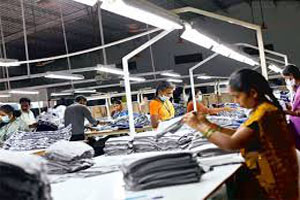
Tirupur textile export to boost further with the signing of FTA with Europe
YarnsandFibers News Bureau 2014-09-03 16:00:00 – ChennaiTirupur, textile city of Tamil Nadu is toady poised for big growth as it looks set to exploit overseas orders that are getting diverted from Bangladesh and China, where the industry is increasingly facing issues related to workshop safety, labour rights, higher wages and political uncertainty.
In 2013-14, knitwear exports from Tirupur logged growth of around 40 pe cent with sales worth Rs 18,000 crore, according to A Sakthivel, president of Tirupur Exporters Association, a body of all major garment exporters in the city. Compare this to the flat graph in 2010-11 and marginal growth in 2012-13.
The performance in the current year too has been good with around 30 percent growth in rupee terms and 15 percent in dollar terms. The whole of Tirupur, is optimistic of maintaining the growth tempo, in fact even doubling it if the government signs a Foreign Trade Agreement (FTA) with the European Union, which consumes about 45 per cent of the city's total production.
According R Raj Kumar, managing director of BEST Corporation, a Rs 700-crore company that supplies to major brands including Mother Care and Hanes, Europe's largest innerwear brand. If India signs the FTA with the European Union, India can take on Bangladesh. Customers recognise that Tirupur is a better place when it comes to quality, delivery and reliability. It is 10 percent higher cost than that of Bangladesh that is keeping the customers away. That is why an FTA will help.
The competition from Bangladesh, arising from the low cost of production there, was one of the biggest threats for Tirupur. Costs in India are 8-10 per cent higher than in Bangladesh (China's products are 10-15 per cent more expensive than those of India). Indian firms have been selling at a margin of 5-10 per cent. In the past five years, it has not increased prices to counter the competition.
However, fortuitously for Tirupur, the past few years have eroded the edge that Bangladesh and China had on garment exports from India. Safety of workers and labour rights has become major concerns for buyers from the West, putting Bangladesh's industry in a crisis. In 2012, hundreds of workers perished in a fire at a factory on the outskirts of Dhaka. Then last year, after the disaster at the Rana Plaza that killed around 1,100 workers, major Western brands stopped procuring products from Bangladesh or scaled down exports. Growth in garment exports from Bangaldesh has slowed to its lowest rate in 15 years, with buyers shifting to countries like India, Vietnam, Indonesia and Cambodia. An industry official from Tirupur, who requested anonymity, said that big brands like Disney and GAP have already diverted their orders to India from Bangladesh and more brands are expected to migrate soon.
A look at the figures for two products - categorised as 338 (M/B knit shirts, cotton) and 339 (W/G knit shirts/blouses, cotton) by the US Textile and Apparel Category System, reveals where Tirupur's future lies. The textile city's share in exports in category 338 has gone from 4.8 per cent in 2005 to 6.6 per cent in the first six months of 2014. In the same period, Vietnam's share rose from 2.3 to 6.8 per cent and that of Bangladesh from 2.3 to 5.7 per cent. China had a market share of 4.6 per cent in 2005. This reached 11 per cent in 2012, but has declined to 9.2 per cent in the first six months of 2014.
In the case of category 339, Tirupur has grown from 2.6 per cent in 2005 to 4 per cent in the first six months of 2014. The figures for Vietnam and Bangladesh rose from 5.1 per cent to 18.2 per cent, and from 1.6 per cent to 3.4 per cent, respectively. Chinese exports grew from 6.4 per cent in 2005 to 24.3 percent in 2013, but have declined to 20.1 per cent in the first six months period of 2014.
The cost of labour, once Bangladesh's unique selling proposition, has doubled since last year. The minimum monthly wage was raised to $68 (around Rs 4,100) last December. It hit the bottom line of the companies, bringing down margins to 1-2 per cent, even nil for some, according to industry sources.
Market Intelligence
Ask for free sample Report

experience
Customer Base
dedicated team
Countries Served Worldwide









